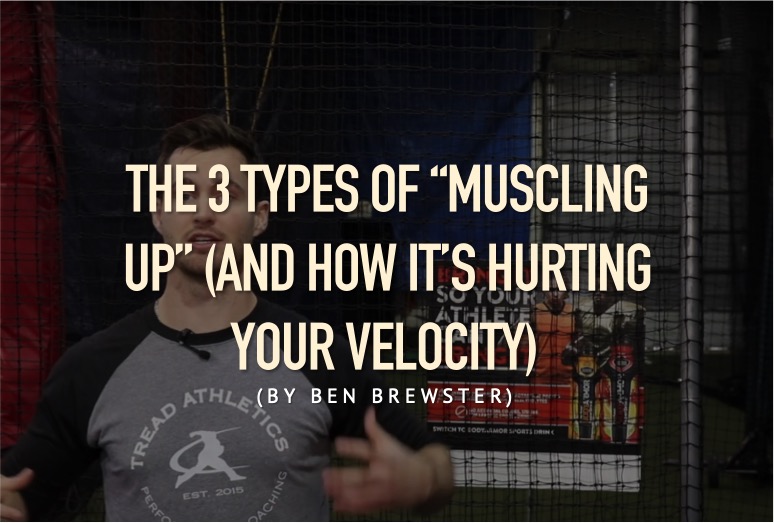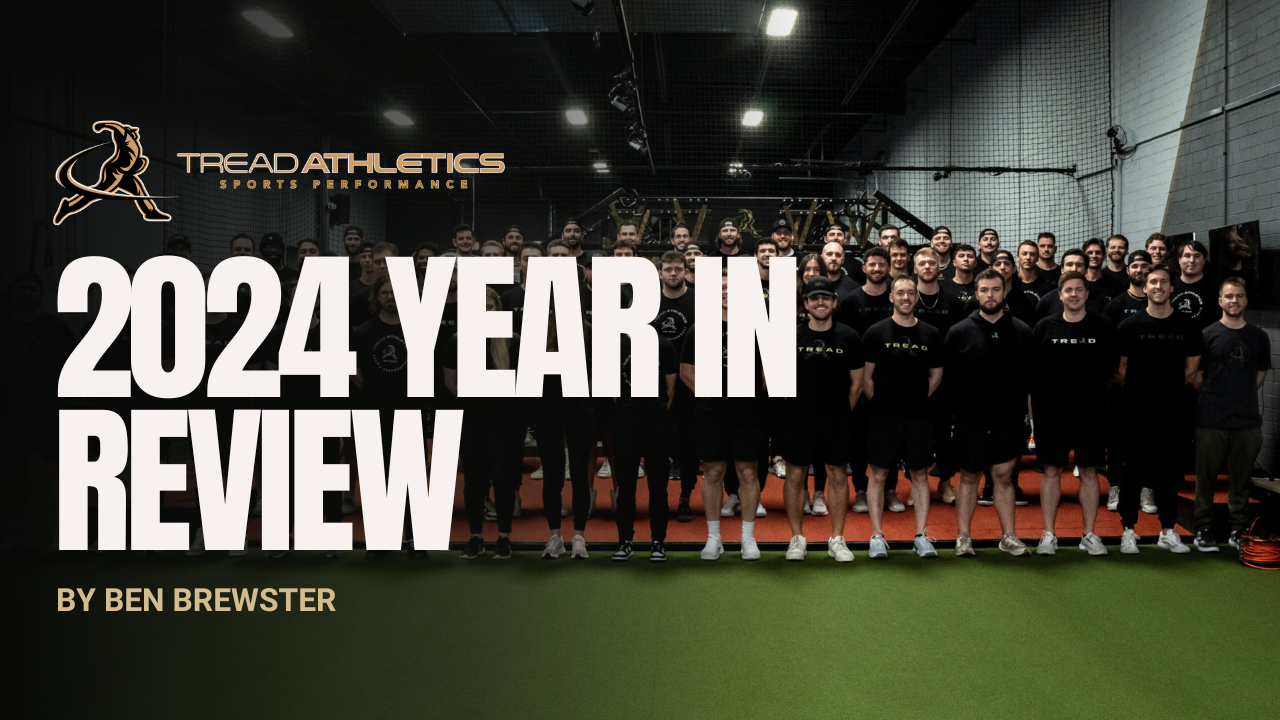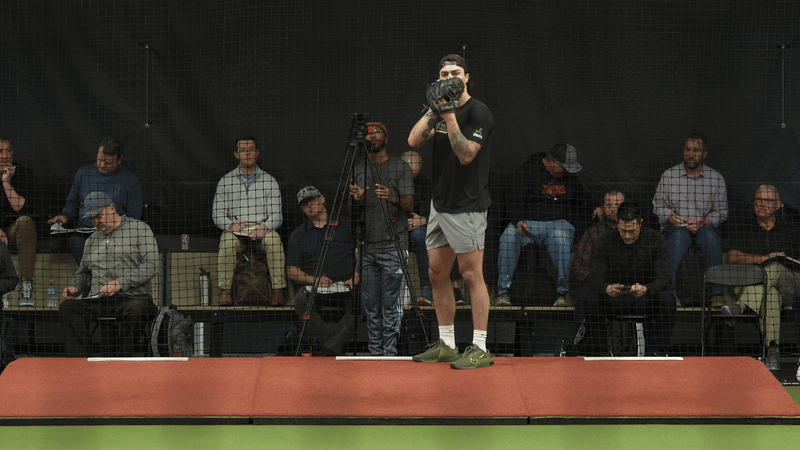by Ben Brewster
This post goes hand in hand with this youtube video. Give it a watch after completing this article.
Last week we broke down 7 of the top causes of a pushing arm action, so let’s switch gears this week to discuss another velocity-killing epidemic: commonly known as “muscling up.” Most of us are familiar with the term, but let’s unpack it a bit more, and break down both what it is, why it hurts velocity, and several ways you can address it in your own delivery or with the athletes you coach.
The Kinetic Chain
To understand “muscling up,” let’s briefly revisit the kinetic chain. The kinetic chain is the familiar concept that the body transfers energy segmentally, from one joint to the next, via our system of muscles, ligaments, tendons and fascia. The word kinetic refers to “the motion of material bodies and the forces and energy associated therewith.”
In this way, each joint is a “link” in a much larger movement “chain.”
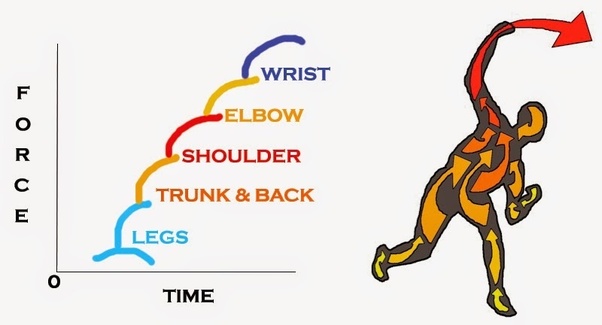
Now, while we can conceptually understand that energy is transferred segmentally, it doesn’t mean that all the energy from one segment is going to be transferred to the next. In fact, that’s not even possible, as it has been shown that a portion of the energy transmitted is not just transmitted through the muscle bellies to the tendons to facilitate movement at the next segment, but through fascial connections that link various chains of muscles together in order to do things like regulate posture, reflexively coordinate muscle contractions, and more.
So some energy is going to inevitably be lost at each link in the chain. The goal then, from an efficiency and energy transfer perspective, is to produce as much usable energy as possible while minimizing segmental energy leakage as it gets transferred up the chain.
It’s not the athlete who laterally bounds furthest off the mound who throws the hardest (although a higher lateral bound correlates with being able to throw harder) – maybe he’s producing the highest lateral ground reaction forces off the rubber, but it becomes unusable energy if it can’t be sequenced into the bigger chain of events to find its way into the back of the baseball.
This is one reason why you’ll sometimes see smaller or less physically impressive athletes who can still throw fairly (and sometimes exceptionally) hard – they might not produce extremely high forces at the segmental level, but they’re able to seamlessly stitch all of this energy together in a way that minimizes energy leakage.
This is why increasing an athlete’s squat will only have a potential benefit if they’re able to tap into that force output in their mechanics and transfer it up the chain. You can squat 600 lbs or jump 40″, but if you don’t efficiently utilize your lower half while throwing, none of that strength or power will find its way to the baseball. Similarly, a guy who squats 225 lbs but creates maximum use of his leverages and taps into every available muscle fiber is going to throw significantly harder than you might otherwise predict.
Does this make lifting useless? NO! It just means you can only out train poor mechanics to a point, at which athletes will run into a very hard plateau.
So what is “muscling up?”
Now let’s revisit this term. Muscling up tends to be thought of in relation to the arm, creating a break in the energy transfer and leading to a loss in velocity from trying to throw harder. While this is one cause and definition, the truth is that muscling up doesn’t always go hand in hand with trying to throw hard (and it can happen even at low efforts), and that it can happen anywhere in the flow of energy (back leg or hips/low back), not just the arm action.
Muscling up is failure to maintain sufficient relaxation in a given joint segment leading to impaired energy transfer and lower ball velocity.
Consider the following clip of a whip in slow motion, noticing the “wave” of energy working its way down the whip. Now imagine the center of that whip had a portion that was rigid and immovable (like a wooden dowel or metal rod). This is effectively what happens when too much tension is held at various parts of the delivery – it leads to an inefficiency in the energy transfer process.
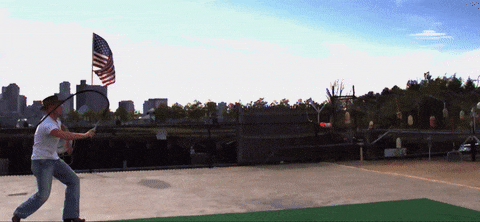
Is being completely relaxed the answer?
Before we get into the 3 main ways that this muscling phenomenon occurs, let me first be clear: just as being overly tense creates blocks in the wave of energy, 100% relaxation isn’t optimal either.
Muscles do need a certain amount of base tension to optimally contract and transfer force, and this level of tension is likely individual specific.
I don’t have an answer as to exactly how much tension is/isn’t optimal at each segment, because I believe it’s based on a number of factors (including genetic ones). However, my feeling is that it’s better to err on the side of being too loose in your mechanics, and add in tension from there based on objective feedback from long toss, radar readings, etc. until you find the balance that elicits the best results.
With the theory behind us, let’s get practical. Here are the three categories of muscling up I tend to see, and some tips for dealing with each one.
1. The rear leg is not relaxing into rotation / landing
In this post, I discussed how I believe that in a high level delivery the lower half passes through three main phases prior to landing: 1) Drift > 2) drive/pulse > 3) relax into hip rotation.
#1: The drift refers to the leg lift, and how it should begin to subtly initiate forward motion to the target, i.e. no balance points or stalling over the rubber. This sets up the drive/pulse phase.
#2: The drive/pulse phase refers to actively incorporating the rear leg coming down out of leg lift. The “pulse” cue implies that it’s a temporary drive, not a sustained push that continues all the way into landing, otherwise you wouldn’t be able to do #3. This phase is your linear energy towards the target, and doing #1 properly allows you to maximally direct it towards the target.
#3: Relax/rotate into hip rotation refers to the transfer of that linear energy into rotational energy by allowing the rear hip/pelvis to relax open into landing while holding the torso/front shoulder closed.
For the sake of this article, we’re going to focus on #3: relaxing into hip rotation/landing. I’ve included here the video and my post below it as well, highlighting the relevant section.

“Drop and drive” and “tall and fall” are both bad descriptors of 100 mph lower half mechanics. A more accurate description: “drift > drive/pulse > then relax into hip rotation/landing.” Drop and drive implies a downward first move, which is not the case. Tall and fall implies little rear knee flexion and minimal back leg involvement which is also rarely the case. Drift, pulse, relax most closely mimics the lower half feeling I’ve felt when throwing upper 90s. As a former all arm thrower, let me tell you – the turbo boost effect you see from efficient lower halves is real. Holding your available hip abduction until center of mass has been shifted is incredibly important. The timing of the drive/pulse is more important than how hard you push into the ground. Differentiating between the drive phase and the relaxation phase is extremely important. Forget to relax back hip into landing and you can’t fully separate and capture that linear energy into rotational energy. What’s interesting is javelin throwers actively cue hanging the back knee into landing because it so clearly improves landing positions, front leg bracing and the ability to transfer that linear momentum through landing.
Here’s a look at the greatest javelin thrower, Jan Zelezny, relaxing the back leg into rotation.
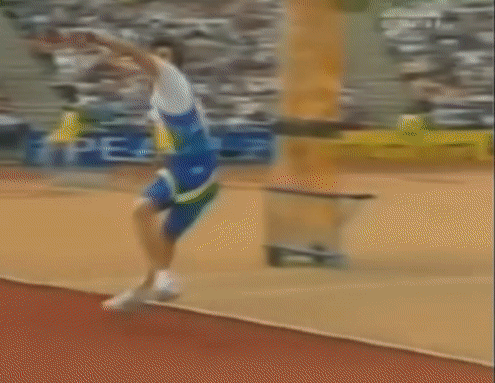
What’s notable about Javelin is the fact that they are “gifted” linear momentum from the run up phase of the throw, whereas pitchers create this linear momentum in the drift and drive/pulse phases of the delivery. Still, rotational transfer must occur to convert that linear energy into rotational energy, and so this is where many of the similarities lie.
So what does this look like in practice? Here are two examples of athletes I’ve worked with remotely.
Notice that during this pulldown, he tries to keep driving off his back leg when it lands, even though the linear momentum has already been created. Rather than capturing that energy as in the Zelezny example, he’s just broken the chain and awkwardly tried to restart the energy transfer by not relaxing the rear hip down and in to landing. His numbers jumped from 86-87 mph to 92-93 the following week once we addressed this issue.
Here’s another case:
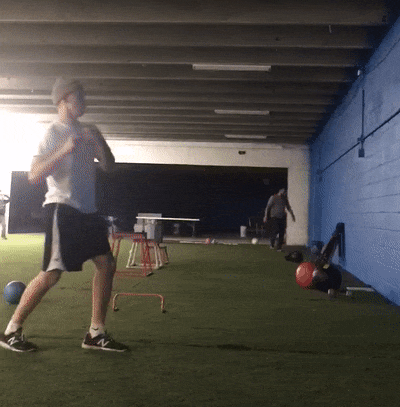
This athlete has been cueing maximal intensity for years, but intent can be a double edged sword if it isn’t properly sequenced. A hard back leg drive that continues through landing isn’t a transferrable drive – that muscling up of the back leg stops him from creating any dissociation between the upper and lower half.
“Intent can be a double edged sword if it isn’t properly sequenced.”
He ultimately flies open and pushes the ball, all as a result of not relaxing the back leg into landing after the drive phase.
What is the solution?
First off, you can just try explaining the concept and cueing to relax the back hip into landing. Another way of thinking of this is the javelin cue of hanging the back knee down and in to landing to get it “out of the way.”

I’m sure you still want some drills, though. Anything where you eliminate the drift and drive/pulse phases to focus on the relaxation/rotational transfer phase will help isolate that movement. Pulldowns are one example that drastically improve this ability to transfer a massive amount of linear energy. When guys struggle to transfer pulldowns to the mound it’s typically not this phase that they struggle with because pulldowns train it well. Of the various pulldown footworks, turn and burns might emphasize this rotation the most, although pick the one that is most comfortable for you.
Beyond pulldowns, here are two more drills to consider. The first is a javelin drill, but it’s basically a modified rocker starting with the arm up at landing. Do this drill throwing the ball on a line or a slight downhill, not uphill as the javelin thrower here is demonstrating. I’d also suggest keeping the elbow at a 90 degree bend, not straightened as this thrower is showing. I’d recommend working up to a 2lb ball at low efforts to feel the drill, then doing the bulk of your reps in the 7oz to 1 lb range, trying to feel the back hip relax and the wave or “tornado” of energy wind up the chain into the arm.
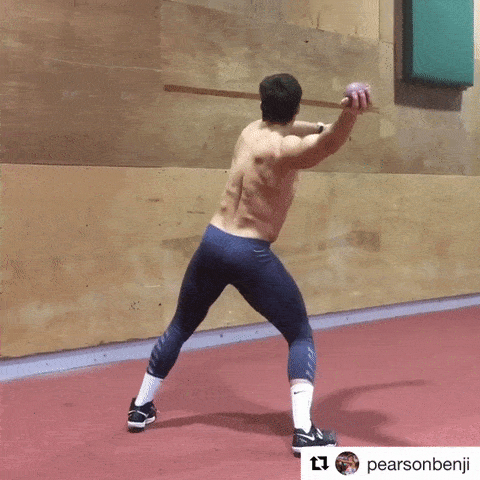
The next is a medicine ball throw where the focus is simply on relaxing the back hip down and in to pop the upper half and medicine ball through.
Use a 2 lb ball – any heavier may tug on the shoulder from this drill. Again, the focus is still on holding the upper half closed and feeling the wave of energy flow through your body. Notice the smoothness, and also notice what reflexively happens to the front leg – it extends and braces very effectively because you’re allowing the hips to get all the way through, which pulls the front knee into extension.
2. The low back isn’t releasing to allow the hips and shoulders to separate.
This is very similar to #1, except that the energy transfer isn’t being killed by the back hip, but by the low back.
What happens is this very forced rotation where the low back and abdominals take over and tense early, not allowing the energy to continue up the chain. This is often linked to #1 – when guys try to spin or rotate their hips open as fast as possible it creates this reflexive tension in the low back (likely a protective mechanism, as I’ll get into in a moment). It has also been shown that hip rotation velocity is not a distinguishing difference between low and high velocity throwers.
Seeing the low back tensing is very difficult – it just doesn’t look like as smooth of a transfer of energy from the hips to the shoulders. It’s a more “blocky” type of rotation – like a boxer trying to power a punch by forcing torso, rather than “floating and stinging,” as made famous by Muhammad Ali.
Perhaps the best way to describe it is to tell my own story. I injured my back sophomore year of college – this was a rotational injury from throwing, stemming from trying to force my hips to rotate as fast as possible, and taking the concept of intent a bit too seriously (I was the slowest thrower on the team but threw my first warm-ups almost as hard as I could). I was mostly an 85-87 guy before the injury.
Coming back from the injury, I was a bit tentative to re-aggravate my low back, so during my rehab throwing I relaxed it and tried to avoid tensing up there as much as possible. After a couple sessions I noticed that the ball was just flying out of my hand (relative to before the injury). I realized that this relaxation was allowing me to transfer energy more smoothly, and ended up coming out the other end of that injury at 88-91 mph almost immediately once I was back to full strength.
3. The arm is overly tensing during arm spiral/layback
I saved this one for last, but it’s probably the most well known form of muscling up: overly tensing the arm at some point from hand break to ball release, often leading to limited horizontal abduction/scapular retraction, layback and velocity relative to their less aggressive throws.
This tensing issue tends to manifest itself to a greater extent when the athlete tries to throw harder or thinks maximum effort. These guys might warm up at 85% effort, but when you pull out the radar gun and tell them to let it eat, they either throw slower or only marginally faster than their warm-up throws.
“When you pull out the radar gun, they either throw slower or only marginally faster than their warm-up throws.”
Sometimes it’s obvious – the patterns visibly change, the throwing arm no longer flips up at landing, the flow of energy loses its smoothness and the glove arm yanks the front side open. Other times, you’ll only know based on seeing the numbers at lower efforts and realizing that there is a break in the chain happening at some point.
In either case, once you have identified the issue, my first step is to reframe what max effort means in a guy’s head.
Are you trying to throw hard or throw loose and quick?
For some, throwing hard brings up this image of tensing and brute forcing their arm through release, a problem they don’t have until the radar gun pops out. Switching that frame of reference to trying to throw as loose and quick as possible now makes the focus about arm speed, and can often help guys.
The other cue I will sometimes use is to imagine the ball is on a string, and that string is your arm. Your pec controls the acceleration of that string, not your hand, tricep, etc. This can work as well – although if you’re having trouble cueing them out of a tense arm action, they could be working through some tissue tension issues and need to open up their upper body if they’re really having trouble relaxing (which we covered in some detail last week).
Worth noting about the second cue is that it entails a focus on proximal over distal – thinking about accelerating the arm or pulling down with the pec or “armpit” allows guys to relax the end of the whip (the hand and forearm).
Case Study: Upper Trap Dominance
Here’s an interesting case study.
Garrett was one of our remote athletes, and his velocity would fluctuate significantly over the course of his starts. In the first inning, his velocity was always at its best – touching 90 or 91 miles per hour. The more he threw, the tenser he would get with his arm action, throwing mostly in the 85-87 range after the first inning.
It’s not that his arm was getting tired – but that his body was beginning to revert to its default movement patterns as the upper trap in his case would tense up and prevent his arm from flowing through his arm spiral.
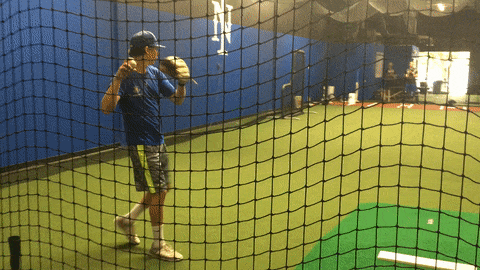
What’s interesting is that even during the intake process (at 6’3″ 178lbs), he showed very large and overdeveloped traps. Whether this hypertrophy caused the trap dominance or the trap dominant pattern caused the hypertrophy (more likely), is hard to say, but it was clear that in order to fix his arm action we would need to address the problem in two ways:
#1: Address the tissue quality of the problem area (upper traps), utilizing self myofascial release techniques (video below) and by prescribing he receive manual therapy, ART and/or dry needling on the area.
#2: Cueing him away from upper trap dominant patterns in not just his throwing but all of his rowing, pressing and other weight-room exercises as well.
So what happened?
Garrett not only went from 178 to 194 lbs, bringing up lagging areas in the rest of his body, but went on to be a 91-94 starter who held his velocity deep into games that season.
Here’s a 93 mph fastball on the last pitch of a no-hitter he threw as a DII Sophomore. Not only was his velocity up, but his velocity maintained deep into games for the first time in his career after addressing the upper trap dominance.
Update: Garrett got up to 96 mph and was drafted in 2019 in the 15th round by the Pirates.
Closing thoughts
Remember, I am not saying that relaxation is always the key – some guys are too loose (my former teammate Mike Shawaryn was one such guy who I would never want to be any looser. Update: he’s now a big leaguer), but many guys do in fact need to learn how to relax a part of their kinetic chain to elicit more efficient energy transfer.
I don’t have the magic formula, but hopefully this post gave you some ideas and cues that you can begin to implement with yourself or your athletes. As with everything, don’t take my word for it: test and retest to determine what works best for each individual.
If you haven’t already, check out our Youtube video on this topic, below. Make sure to subscribe there to get notified when we post new content!
If you have any questions, email us or reach out to me on twitter.
As always, thanks for reading!
Here’s to reaching your potential,
Ben
Athletes or coaches interested in remote one-on-one or team programming? Reach out via this application form.

